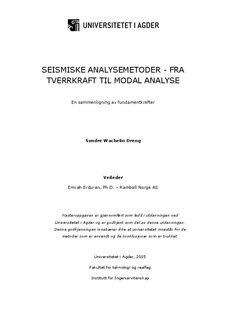| dc.contributor.author | Dreng, Sondre Wachelin | |
| dc.date.accessioned | 2015-09-14T12:54:15Z | |
| dc.date.available | 2015-09-14T12:54:15Z | |
| dc.date.issued | 2015 | |
| dc.identifier.uri | http://hdl.handle.net/11250/299716 | |
| dc.description | Masteroppgave bygg- Universitetet i Agder, 2015 | nb_NO |
| dc.description.abstract | This is a master's thesis written in the topic of civil engineering science at the University of Agder in
the Institute of Engineering science located in Grimstad. The thesis is a study of results from three
different seismic analysis of a thirteen story building, a six story building and of a constellation of
these two buildings on a combined basement. The collected results is gathered from analysis
according to the requirements given in the Eurocode 8. The purpose of this thesis is to determine the
differences in baseshear forces from the lateral force method, an equivalent model and from a
detailed modal analysis of the buildings. The main question to be answered is the equality between
the result ratios for the equivalent models with or without seismic joints and the detailed modal
analysis model with or without seismic joints. Which gives the main purpose of this thesis. To
determine the accuracy of using equivalent models to determine the effects of implementing seismic
joints.
The baseshear results are varying for each method and the two different buildings with a deviation of
-29.7 % (equivalent model) to -40.4 % (lateral force method) for the thirteen story building. For the
six story building the deviation was 17.3 % (equivalent model) and -45.3 % (lateral force method).
These variety of results is expected to be related to the difference in natural periods of the buildings
due to the similarity in stiffness and mass distribution. The results also shows why the lateral force
method is not a valid method in this case because of the higher natural periods and that it lacks the
opportunity to calculate the effects of intended eccentricity . Both the analysis of equivalent models
and the detailed models gives satisfying results. They intend to show that implementing seismic
joints in this case, gives a higher baseshear force by 687 kN for the equivalent model and by 772 kN
for the detailed model. The similarity of the results from the equivalent model and the detailed
model shows that in this particular case, the equivalent models could have been used to determine if
seismic joints is effective or not with an uncertainty of 5.2 %. | nb_NO |
| dc.language.iso | nob | nb_NO |
| dc.publisher | Universitetet i Agder ; University of Agder | nb_NO |
| dc.subject.classification | BYG 500 | |
| dc.title | Seismiske analysemetoder - fra tverrkraft til modal analyse En sammenligning av fundamentkrefter | nb_NO |
| dc.type | Master thesis | nb_NO |
| dc.subject.nsi | VDP::Technology: 500::Building technology: 530 | nb_NO |
| dc.source.pagenumber | 193 s. | nb_NO |
